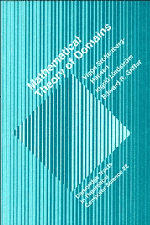Book contents
Chapter 11 - Power Domains
Published online by Cambridge University Press: 05 June 2012
Summary
Power domains were introduced by Plotkin [1976] in order to give a semantics for non-deterministic or parallel programs. Assume that each run or possible outcome of a class of non-deterministic programs has an interpretation in a fixed domain D. Then an interpretation of a non-deterministic program in this class would be the set of interpretations of all possible outcomes of the program. Thus an appropriate domain to interpret this class of non-deterministic programs should be something analogous to the power set of D, let us call it a power domain of D. In this chapter we shall introduce three concepts of power domains, due to Smyth [1978], Hoare and Plotkin [1976], respectively. It turns out that Scott–Ershov domains are closed under Smyth's and Hoare's power domain operations but unfortunately not under Plotkin's. The class of countably based algebraic cpo's (we call these quasidomains) is closed under Plotkin's power domain construction. However, as we observed in Chapter 3, this class is not satisfactory for semantics, since it is not closed under the formation of function space. Therefore we introduce the class of SFP-objects, a subclass of the quasidomains, which is closed under all three power domain constructions as well as under the formation of function space. In fact the category of SFP-objects is the largest full subcategory of the category of quasidomains which is cartesian closed. Thus every countably based Scott–Ershov domain is an SFP-object but there are SFP-objects that are not domains.
- Type
- Chapter
- Information
- Mathematical Theory of Domains , pp. 283 - 309Publisher: Cambridge University PressPrint publication year: 1994

